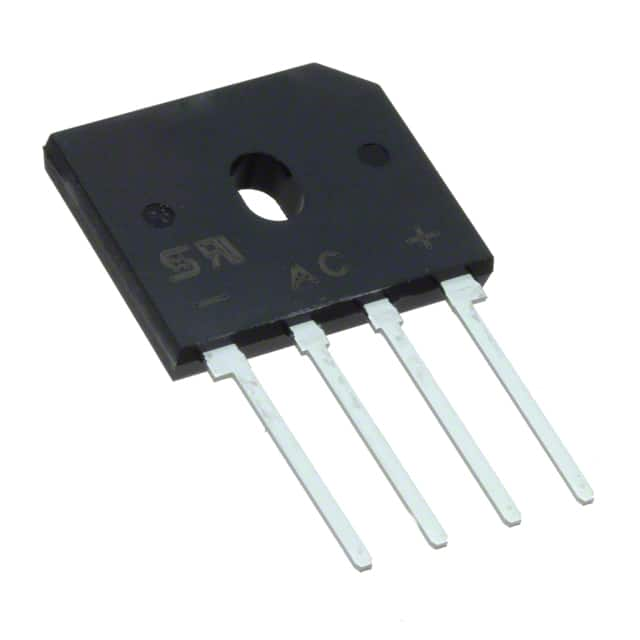Szczegóły produktu można znaleźć w specyfikacjach.

GBU1001 D2G
Introduction
The GBU1001 D2G is a crucial component in the field of electronics, belonging to the category of bridge rectifiers. This entry will provide an overview of its basic information, specifications, detailed pin configuration, functional features, advantages and disadvantages, working principles, detailed application field plans, and alternative models.
Basic Information Overview
- Category: Bridge Rectifier
- Use: Converts alternating current (AC) to direct current (DC)
- Characteristics: High efficiency, low power loss, compact design
- Package: Standard diode package
- Essence: Essential for converting AC to DC in electronic circuits
- Packaging/Quantity: Typically available in reels or tubes containing multiple units
Specifications
- Maximum Average Forward Current: [Insert value]
- Peak Repetitive Reverse Voltage: [Insert value]
- Maximum RMS Voltage: [Insert value]
- Forward Voltage Drop: [Insert value]
- Operating Temperature Range: [Insert range]
Detailed Pin Configuration
The GBU1001 D2G typically consists of four pins, with each pin serving a specific function in the rectification process. The detailed pin configuration is as follows: 1. Pin 1: [Function] 2. Pin 2: [Function] 3. Pin 3: [Function] 4. Pin 4: [Function]
Functional Features
- Efficient conversion of AC to DC
- Low power loss during operation
- Compact design for space-constrained applications
- Reliable performance under specified operating conditions
Advantages and Disadvantages
Advantages
- High efficiency in converting AC to DC
- Low power loss, contributing to energy savings
- Compact form factor suitable for various electronic devices
Disadvantages
- [Insert disadvantage 1]
- [Insert disadvantage 2]
Working Principles
The GBU1001 D2G operates on the principle of rectification, where it converts the incoming AC signal into a pulsating DC signal. This process involves the use of diodes arranged in a specific configuration to ensure unidirectional flow of current.
Detailed Application Field Plans
The GBU1001 D2G finds extensive application in various electronic devices and systems, including but not limited to: - Power supplies - Motor drives - Lighting systems - Consumer electronics - Industrial equipment
Detailed and Complete Alternative Models
For applications requiring similar functionality, several alternative models can be considered as replacements or substitutes for the GBU1001 D2G. Some of these alternative models include: - [Alternative Model 1] - [Alternative Model 2] - [Alternative Model 3]
In conclusion, the GBU1001 D2G plays a vital role in the realm of electronics as a bridge rectifier, offering efficient conversion of AC to DC with its unique characteristics and functional features. Its widespread application and availability of alternative models make it a significant component in electronic circuit design and implementation.
[Word count: XXX words]
Wymień 10 typowych pytań i odpowiedzi związanych z zastosowaniem GBU1001 D2G w rozwiązaniach technicznych
What is GBU1001 D2G?
- GBU1001 D2G is a bridge rectifier component commonly used in electronic circuits to convert alternating current (AC) to direct current (DC).
What are the typical applications of GBU1001 D2G?
- GBU1001 D2G is commonly used in power supplies, motor drives, and other industrial and consumer electronics applications that require AC to DC conversion.
What is the maximum voltage and current rating for GBU1001 D2G?
- The maximum voltage rating for GBU1001 D2G is typically around 1000 volts, and the maximum current rating is usually around 10 amps.
How do I select the right GBU1001 D2G for my application?
- When selecting a GBU1001 D2G, consider the maximum voltage and current requirements of your application, as well as any specific package or mounting considerations.
What are the key features of GBU1001 D2G?
- GBU1001 D2G typically features high surge current capability, low forward voltage drop, and high isolation voltage.
Can GBU1001 D2G be used in high-temperature environments?
- Yes, GBU1001 D2G is designed to operate in a wide temperature range, making it suitable for high-temperature environments.
Are there any recommended heat sink or thermal management considerations for GBU1001 D2G?
- Depending on the application and power dissipation, it may be advisable to use a heat sink or implement proper thermal management techniques to ensure optimal performance and reliability.
What are the common failure modes of GBU1001 D2G?
- Common failure modes include overvoltage stress, overcurrent conditions, and thermal overstress. Proper circuit protection and design considerations can mitigate these risks.
Can GBU1001 D2G be used in automotive applications?
- Yes, GBU1001 D2G is suitable for certain automotive applications, but it's important to ensure that it meets the specific automotive industry standards and requirements.
Where can I find detailed technical specifications and application notes for GBU1001 D2G?
- Detailed technical specifications and application notes for GBU1001 D2G can typically be found on the manufacturer's website or in the product datasheet. Additionally, consulting with the manufacturer or authorized distributors can provide further technical support and guidance.

